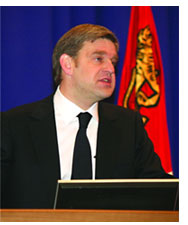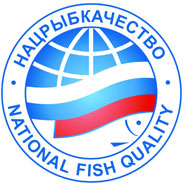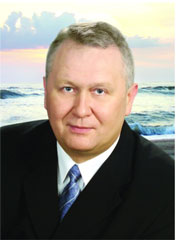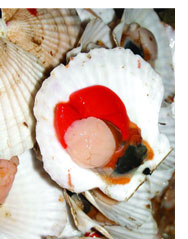Interview with the Governor of the Primorsky territory, Serguey Darkin.

Regardless the measures undertaken, - the crisis situation in the fishery industry hasn't been overcome. Within last four years the TAC volumes decreased from 3.7 million tons to 3.1 million, there are practically closed the operations to catch fish and sea products in the EEZ of foreign countries and in the open areas of the ocean. The per capita consumption of fish in Russia amounts to some 12 kilograms a year, i.e. twice as less as the norm. The Governor of the Primorsky territory, Serguey Darkin believes, that, first of all, the re-orientation of the whole fishery industry is required: from the supplies of raw fish to the supplies of ready fish products of the secondary processing.
However, notwithstanding the problems and the difficulties there are positive trends in the Primorye fishery industry development. The total catching output in 2006 by all the Primorye fishery enterprises amounted to 636 thousand MT, i.e. 101.2% to the previous year. Positive dynamic is seen in the financial and social spheres.
However, at present a number of fishery industry's problems aren't resolved. Thus, until now the market mechanism of the shares' turnover isn't operational, the quotas to fish still remain the object of speculation and violations. Of negative impact upon the effective functioning of the industry there are also the problems of incompleteness of normative-legal regulation of fishing, a high level of poaching, high level of the fishery fleet wear, lack of the State support for the producers. There should first be optimized the functioning of the governing bodies. We stand for the decisions in the fishery sphere to be adopted by a unique Federal body. Then the realization of the basin principle of management should be implemented. And a radical measure to protect and to control the use of the marine living resources there must become the obligatory declaration of the products produced out of the water resources of the Exclusive Economic Zone and on the continental shelf in the sea ports of Russia.
Our main task is o create the conditions for the fishery industry development. For a long time Russia has been the member of the world fish market and to-day we must use more fully the unique possibilities we possess.
THE PLAY TO NEW RULES
Interview with the Director of the Federal State enterprise "National Center of quality and security of fishery products" (FGU NATSRYBKACHESTVO), Alexey Emeksizov.

Within the administrative reform, underway as of late in our country, there was established a system of control and supervision over the security of all the food products. FGU NATSRYBKACHESTVO, being the integral part of the ROSSELKHOZNADZOR, is responsible for the security of fish products. Among the most important directions of the FGU NATSRYBKACHESTVO for 2007 is the establishment of the "Reference-Laboratory" to be located in Moscow.
Alongside with that we work over the development of certain methodic which would help us in the future to harmonize the Russian legislation with the European one in this sphere. Another priority task for us, for Russia to be n the eve of entering into the World Trade Organization, is to ensure the production of secure fish products by enterprises and organizations of the Russian fishery complex. With the purpose we hold necessary consultations at preparing the vessels and enterprises for the production of products in correspondence with the international safety requirements. We render services to form and to actualize the available normative documents fund, including the Directives and standards of the European Union.
FGU NATSRYBKACHESTVO helps with consultations on the issues of technologies, microbiology, veterinary, standardization, certification of the HASSP systems, etc. Without the HASSP systems' use in the new conditions the home producers would really loose the sales markets. Still, staying on the threshold of the WTO we have a little time. Very little time…
FISHERY INDUSTRY REVIVAL IS IN THE FISHERMEN HANDS!
By Yuriy Moskaltsov, "DALRYBA" JSC President.

On March 28, 2007 in Moscow there was held the session of the All-Russia Association of fishery enterprises, entrepreneurs and exporters (VARPE) Council.
Yuriy Moskaltsov, also the Vice-president of the VARPE told about the results of the session.
In general, there are positive shifts in the work of the VARPE. One of the most important achievements in the VARPE activities can be considered the preparatory work of the new reading of the Article 25.1 of the RF Tax Code, referring one of the most important issues of the fishery industry - the new rates for the use of the marine living resources and the new procedure of their calculation and payment order. Also we finish the work over a number of documents to be considered at the session of the State Council. As of late the VARPE specialists accomplished the expertise of a dozen of normative-legal documents of significant importance for the development of the fishery industry.
Ardent fishery problems, like taxation, fuel prices rise, deterioration of the resource base and the obsolete material base of the industry - will be regarded at the 2d All-Russia Fishery Congress, the preparation for is underway. As for the VARPE, there are proposals its functions should be added, namely: VARPE should accomplish expert evaluation of all the proposals in the sphere of the State policy in the fishery sector, it should participate to the preparation of inter-governmental fishery agreements, to elaborate the recommendations for the Federal Fishery Agency in the camp of scientific researches for the fishery. We think that these functions should be financed from the State budget.
"FISHERING SERVICE", KALININGRAD, RUSSIA
Interview with the Director of the "Fishering Service", Fiodorov A. N.

Our company is working with the ship-owners fishing practically in all the areas of the World ocean.
Wherever the fishermen work all the time a regularity can be detected: the companies which pay more attention at the technical equipment of their vessels are developing more steadily and successfully. The use of all the time being sophisticated equipment and fishing gears permit to increase the catching results even in the situation of the worsened catching situation. The first example of that could be seen in 1999, at catching in the Mauritania zone - by the end of 2001 the majority of the Russian fishing companies drove their vessels out of the Mauritania zone, because of poor catching results. However, at the same time the other foreign vessels working there were showing stable high catching outputs. The thing was the obsolete trawls the Russian used there.
The company and its specialists started to study the physical and mechanical properties of the materials the trawls were made of, thus in the end we managed to create a first trawl with increased catching zone in Russia, the "RAPTOR 182/8500". It coincides with the date of establishing the "Fishering Service" company, June 2002. The experience and knowledge obtained while working permitted to the company to start the production in series, in February 2005, the trawl "TYPHOON", having the length of scrape together of more than 200 meters. On the basis of this trawl in March 2006 there was elaborated the "SHKVAL", then in the summer - "SUPERSHKVAL" trawl, having the square to incorporate four soccer fields, i.e. the biggest trawl in the world.
Another successful project was the "TORNADO" trawl, which is very popular with the vessels of 3,500 HP engine capacity. Alongside with the new models the "oldies but goldies" models are still favorite: "SKAT" (133d trawl) and "RAPTOR" series trawls.
We studied to produce constructions, which correspond with their characteristics to the most daring fishermen dreams, which would permit to enlarge their fishing horizons.
A THORNY PATH OF THE AQUACULTURE DEVELOPMENT
To-day quite a half of the fish and sea products consumed by the humanity are the species raised in captivity, at specialized farms to produce water biological resources. If in 1980 only 9% of all the requirements in the world were satisfied with the aquaculture products, at present this figure amounts to 43%. In Russia the natural conditions permit to develop this kind of activity, our country possesses immense potential fund - more than 25 million hectares of lakes and water reservoirs, some 0.4 million hectares of coastal waters, etc. However, as of to-day only 5-6% of this fund are being used for the purposes of aquaculture.
At present in Primorsky territory there are operational 36 enterprises of sea farming, which in accordance with the law in force were allocated 78 fishing areas of the total square of some 10 thousand hectares. The main cultivated species are the Scallops, Laminaria sea-weed, Mussels. In 2006 the aquaculture enterprises totally produced 1,339.9 tons of the products, out of them 479 tons of Scallops, 41.4 tons of Mussels and 818 tons of sea-weeds. Within the period 2004-2006 no growth in the number of aquaculture enterprises was registered.

The problems of legal character curb the development and the growth of number of aquaculture enterprises. Lack of legal protection, high risks, high level of expenditures and a rather long pay-off period are producing negative impact upon the financing of this sector of the industry.
Problem of technological character is another stumbling stock for the aquaculture development. Besides, either negative influence is produced by lack of due protection of the farms' sea grounds, low social-economic development of the adjacent territories, etc.
Anyhow, especially the Primorsky territory has a significant potential for not only the aquaculture, but for fish-farming as well. The total square of the potential plantations in Primorye amounts to 3,758 square kilometers, where some 618 thousand tons of hydro-bionts can be produced annually. The most productive is the Northern Primorye, where the total amount of an annual crop can amount to some 350 thousand tons. At present the plantations in Primorye occupy some 80 square kilometers, producing some 1,000 tons of products a year.
However, there are being elaborated the ways of development and the future growth of aquaculture in Primorye. One of the possible way could be the establishment of Marine parks, as a form of territorial integration of science and the production. With that the State has also made its step in this direction with the inclusion of the measures to develop the aquaculture sector in Russia into the Federal National Project "Development of the agricultural-industrial complex", Specific measures to contribute to the aquaculture development are foreseen by this program.
An important step that could really help in solving many problems, standing in front of the aquaculture development in Primorye, there could be an establishment of the Association to unite all the entrepreneurs involved in the sector now, as being united means being stronger.
SOME REMARKS ON CRABS' AND SHRIMPS' IMPORT TO JAPAN AND TO SOME OTHER COUNTRIES FROM RUSSIA
The events of the latest years show that the crabs and shrimps, being the most precious exportation products are being over-exploited and the amounts of their catch significantly exceed the official figure of the TACs and other reported statistics. As a result of such a situation there occur over pouring of markets, prices drop and in the result - the financial losses of fishermen.
In 2006 Japan imported 3.152 million tons of sea products (that is some 35% of the domestically consumed amount). The share of Russia amounted to 221 thousand MT (in 2005 - 213 thnd MT), the main imported species were: crabs - 73,467 tons, shrimps - 9,518 tons, Alaska Pollack roe - 14,181 tons, etc.

Specifically, in 2006 Japan imported 52.2 thousand tons of products made of Snow-crabs (in 2005 - 53,400 tons). The TAC of Snow crabs in 2006 was established at 47,747 tons and the real catching output, in accordance with the companies reports amounted to 19,956 tons. Thus, right only the Japanese import exceeds the 2006 TAC figure by 2,300 tons and the real catching output figures - two times as much. Even more drastic figures can be seen in the situation with the Hair crab, as in 2006 the volume of export of this product to Japan amounted to 3,631 tons, while the TAC figure was 280 tons only and the reported data - mere 37 tons! Thirteen times as much as the TAC volume! The same situation can be seen at the Shrimps' market. The Japanese distributors note, the prices for Northern shrimp delivered from Russia steadily decrease: within a year they dropped by quite a dollar.
Thus, only the analysis of Crabs and Shrimps import data to Japan from Russia testifies the exceeding the TAC volumes and multiple exceeding the real catching data reported. If taken into account other countries, importing sea products from Russia (China, South Korea, USA, etc.), it's possible to calculate that the total amount of deliveries there from Russia in 2006 amounted to 150 thousand tons of crabs, while the TAC figure was established at 56,938 tons and the reported amount of the real catching output was just 28,414 tons.
All the facts listed above prove: the ministries and the agencies obliged to control the catching output and the export operations aren't fulfilling the RF Laws. If urgent measures won't be taken in the nearest times - these species of the marine living resources will be exterminated and disappear together with the law-obedient fishermen. The weak point of poachers remain the transportation of fish products and the financial currents, another important weak point of them is the publicity. The State must more actively and effectively use these levers to stop the poaching.
SOME FACTS OF THE WORK OF THE SAKHALIN REGION'S FISHERY COMPLEX IN 2006 (ACCORDING TO THE SAKHALIN REGION'S DEPARTMENT OF FISHERY INDUSTRY)
As of 01.01.2007 the total catching output of the marine living resources on all the types of quotas amounted to 460.1 thousand tons, i.e. 97.6% to the level of 2005.
The industrial quota in the exclusive economic zone of the Russian Federation (including the coastal fishing quotas) was used 58.3% (in 2005 the quotas were used 60.3%). Compared to the previous year the percentage of the quotas' use amounted to 97.6%.
The main species to catch for the Sakhalin region's fishery companies are: Pacific Salmon, Alaska Pollack, Wachna Cod, Pacific Cod, Herring, Flounder, Greenling, Saury, Squid.
The share of Alaska Pollack in the total catching output in 2006 amounted to 42%. Thanks to the favorable catching conditions in the Bering sea, the use of quotas there was at the level of the previous year, i.e. at 95%.
PROBLEMS OF THE FAR EAST FISHERY INDUSTRY
In the Chinese province of Dalyan like mushrooms after rain there are growing fish-processing factories of impressing capacity. They process the fish caught in Russian waters. The products, mainly the fillets of Alaska Pollack, Salmons and Cod are being exported to Europe, America and - back to Russia. China, practically not having an own resource base became a leader among the exporters of the processed fish and dictating the prices at the European market. While Russia, having immense own resources, is increasing the import of fish products. Russia is consuming all the much of not only the Chinese fish fillets, but the grassy Norwegian Trout, raised at antibiotics and weight increasing additives, etc.
While foreign provinces are flourishing with the Russian raw materials - the population of Kamchatka is decreasing (by 100 thousand people within last 15 years), 16 Russian sea fishing ports are in decay.
The two main problems of the Far East fishery complex are, in short: poachers and the raw-oriented export. Something should be done with the poachers - the maximum damage they inflict not to the State, but to the fishermen. But to combat the poaching with only the force and laws is impossible. Economic measures are needed. And the first measure there could be an obligatory declaration of the fish caught in the Russian waters - in the Russian ports, like all the world does.
WHAT KINDS OF "TONS" ARE BEING USED IN THE WORLD?
As it's known, in accordance with the International system of measures and the State standards in force in Russia, the unit of mass is the "kilogram", which is one of the seven principal physical units of measurement.
Alongside with the "system unit" of kilogram, the extra-system unit is accepted to measure the physical parameters, i.e. one ton, which is equal to one thousand kilograms. That is the first ton. Also there exist such units of measurement as the ton-mile and the ton-kilometer - they are used to measure the turnover of cargoes.
The second ton is the long ton, or the grob ton, also known as the dead weight ton - it is equal to 1, 016.05 kilograms.
The third is the short ton, or the het ton - shton, mainly used in the English-speaking countries, it is equal to 907.185 kilograms.
The fourth ton is named the ton assay - the measure of weighing the precious metals, in the USA it is mere 29.1667 grams, in the Great Britain - 32.6667 grams.
The fifth kind of the ton is the register ton, reg ton, which is the unit of measuring the internal capacity of a vessel (the volume of internal premises of a vessel), it is equal to 100 cubic feet, either 2.831685 cubic meters.
The sixth ton is the vessel's ton, which is the freight ton, or measurement ton, equal to 40 cubic feet, i.e. 1.132674 cubic meters.
The seventh is the displacement ton, a unit to measure the volume in certain countries, equal to 30 cubic feet, i.e. 0.849050 cubic meters.
And finally the eighth ton is the conventional unit to measure the capacity of nuclear explosion and is equal to the explosion of one ton of the TNT.
That variety of tons should be taken into consideration by specialists in dealing with their foreign partners.
YOUNG FOREVER - THE STUDENTS' FISHING SEASON TEAM
On April 3 this year in the Vladivostok Youth Palace there was celebrated the 45th anniversary of one of the eldest students' teams and the first fishing season team in Russia "Blue Meridian".
The students' fishing season team "Blue Meridian" was established in 1962, at the initiative of the VLKSM (All-Union Lenin communist union of youth) Committee of the Far East State technical fishery University. The first working grounds for the Team used to be the fish-processing factories of the Shikotan island. The Team contained detachments from Irkutsk, Khabarovsk, Barnaul, Nakhodka and other cities of the USSR. It was rather difficult to become a member of the Team, as the competition there was 16 persons per one job. Students were working at the most modern equipment, they accustomed to the whole production cycle, but the most important thing was the young people studied to earn money. By all means, that was a perfect school to prepare leaders.
After the collapse of the Soviet Union the students' movement decayed either, but as of late the "Blue Meridian" sees its revival. To-day the fishing season team "Blue Meridian" is acknowledged to be one of the best students' team in the Far East region. Normally for a fishing season team there exists a quota of 50 persons, but the "Blue Meridian" is permitted to take some 100 students this year to work. Students have to work hard: last year within the three months of the fishing season the Team members processed some 14 thousand tons of fish and their salaries amounted to 60,000 Rubles and more.

